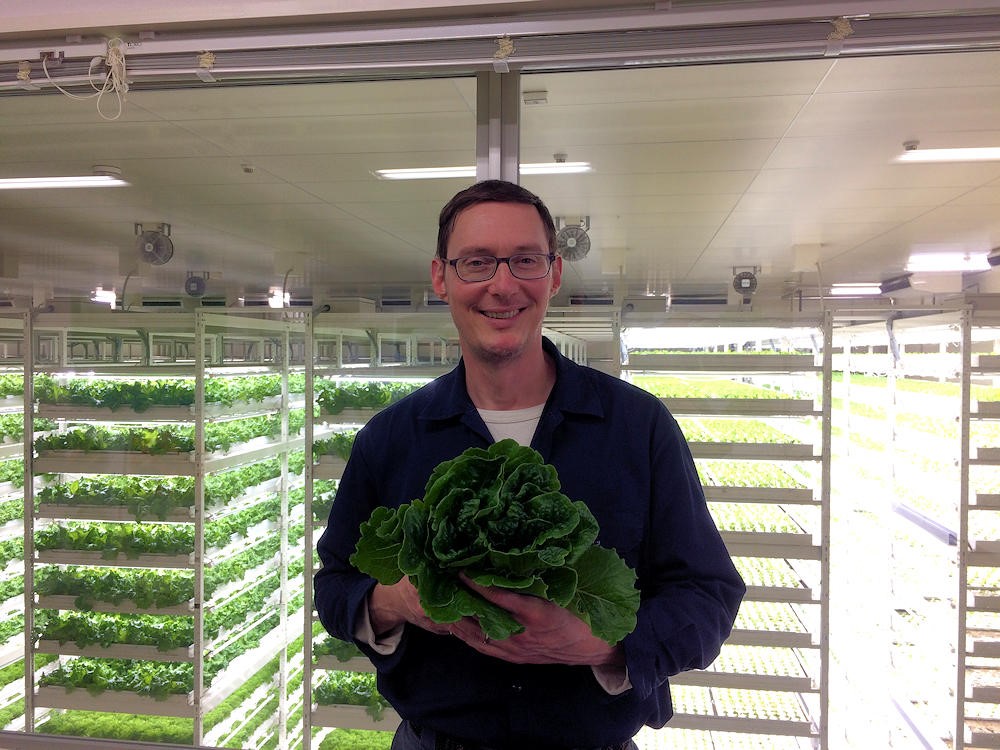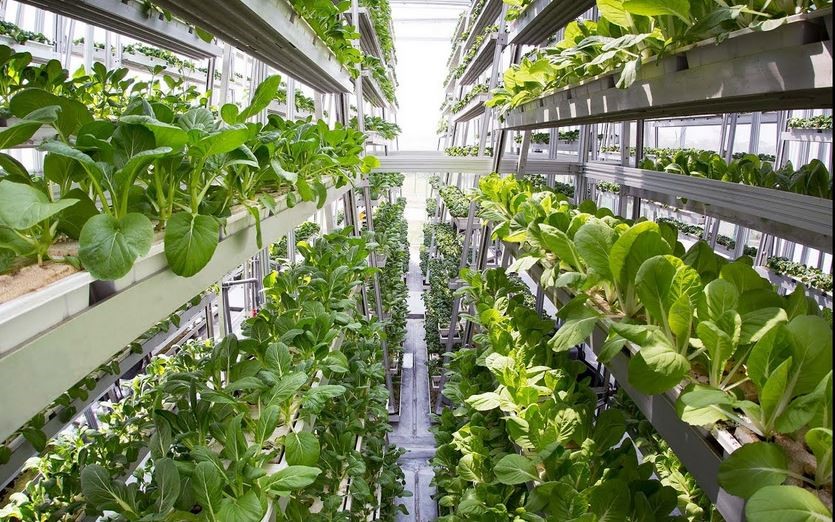Last Saturday we packed the kids into the minivan and navigated the highways, bridges, and tunnels of the most populated metro area on earth, destined for Chiba, home of Tokyo Disney, but we wouldn’t be visiting the Magical Kingdom again today. Our destination was an indoor vertical farm called MIRAI. The only problem was that I still wasn’t sure why.
A few weeks earlier I had contacted Spread, near Kyoto, operator of the largest indoor farm in Japan, but they had turned down my request for a tour. By some miraculous coincidence my wife knew the CEO of Mirai from her university days, a gentleman named Nozawa Nagateru. I was surprised and elated when he agreed to give me (us) a personal tour of their Chiba farm. I would’ve preferred to go alone; but I needed my wife there for introduction and translation, and with her came the kids.
The drive from our place on the Shonan coast was an hour and a half. My eyes were burning with seasonal allergies. Spring was the season of suffering for many people in Japan.
As we crossed the Yokohama Bay Bridge, I caught sight of the cruise ship that had been in the news. There were some people with COVID-19 “Corona” virus on board.
Mirai grew produce in clean room environments, where workers wore full body suits and breathing gear, sanitized in an airlock before going in. It was better quality control than whatever they were doing to contain the virus on the cruise ship. A day or two in that clean room and my allergic reactions would also subside.
Entering Tokyo, the kids slept and I got the head space to think about what I was going to ask Nozawa-san. How would represent myself to him? Why was I visiting an indoor farm? I wasn’t a journalist. I wasn’t a horticulturalist. I didn’t know anything about growing plants. Never mind the fact that I didn’t have a business card, the obligatory prop of any professional engagement in Japan. At least we were bringing souvenirs from our hometown of Kamakura, and a paperback copy of my book. I had worked in information technology for most of my life, and I was the author of an unknown novel that happened to feature a character who abandoned his corporate gig for a life of helping people and growing things indoors. If anything I was an otaku (geek). There were otaku obsessed with everything from Pokémon to bullet trains, so why not vertical farms? Either way, I was going on a whim and a dream, armed only with the desire to work with beneficial tech.
The Mirai farm consisted of a couple of tidy, non-descript warehouse buildings tucked into the midst of an industrial zone. A mob of uniformed workers from a nearby factory smoked cigarettes outside the convenient store down the street. If anyone had to pick the most unexpected place to find tens of thousands of vibrant green plants, this was it.
We parked in front of the main building and Nozawa-san met us outside. We exchanged greetings Japanese-style and he ushered us to the side of one building. Inside and upstairs, we entered an observation room overlooking a vast space containing rows of illuminated towers ten meters high, each containing thousands of plants in various stages of growth. Monitors on the wall displayed graphs of data points collected from the farm below, as well as from other facilities, both local and remote. “Mirai” meant “future” in Japanese, and they lived up to their name.
Nozawa-san poured green tea into paper cups and we sat down at a table to talk. His company was one of the early pioneers of indoor farming technology, with over fifteen years in the business. Their unique, data-driven approach to cultivating perfect produce could be described as precision farming, focusing on the balance of over two hundred growing factors. Like all vertical farms, their main selling points were steady, reliable production of perfect produce, at a fair price. Of course their products were free of pesticides and GMO’s. Best of all, their vegetables tasted great. We sampled fresh romaine lettuce and basil from a platter on the table. Each plant was ninety-five percent edible, with minimal stalk to throw away. Their produce was clean at harvest time. No need to wash.
Aside from the Chiba facilities, Mirai owned and operated a lab and another large farm in Tagajō, Miyagi prefecture, the area hit hardest by the Great Tōhoku earthquake of 2011. I asked if this lab was built in response to the doubly-whammy natural and manmade disasters there. Yes! Absolutely, he said. They chose this site to help the area recover, and to demonstrate the benefit of their tech. Sendai wasn’t too affected with fallout from the Fukushima meltdown, but I guessed their clean room facilities would be immune to radioactivity, as well as to pollen, vermin, and disease.
Mirai sold their design and built farms in numerous locations that were hard-pressed with resource issues and-or harsh weather conditions, with successful operations in Antarctica, Northern China, Mongolia, and Russia. Nozawa would soon visit Norway to consult on the construction of a farm there. Mirai was a leader in urban farming, too, having built farms in cities like Tokyo, Shanghai, and Beijing.
Mirai’s yield is up to one hundred times more resource efficient than traditional farming, using just two percent of the water and a fraction of the land. Their primary expenses were electricity (for the LED lights, the pump, cooling, and control systems) labor, and insurance.
Not knowing anything about the business, I asked the most common sense question on my mind: what would it take to make Mirai more cost-efficient than traditional farming? Sure, their product was of the highest quality and healthier on every level, but at what point would it make more economic to grow produce with the Mirai method as opposed to traditional farms? It turned out to be a good question. Mirai’s solution was in the size of plant. By growing bigger plants they could essentially get more bang for the buck. It wasn’t as simple as that, of course. Other operations, like Spread, got more bang for the buck by growing smaller plants and harvesting quicker. It was a complicated equation of precision farming, taking into account numerous factors of resource usage, output, and time.
Next I asked Nozawa-san what he thought of the impending world food crisis, and how Mirai might play a role. He was of course aware of American vertical farm marketing campaigns, but he answered flatly: “starving people don’t want lettuce”.
Excellent point. Poor countries facing population explosions and resource deficits needed protein and grain. The best answer to this problem was the kind of work done by George Kantor, Senior Systems Scientist with Carnegie Mellon University’s Robotics Institute, Farm View project, whose work focused on using technology to accelerate the efficiency of traditional farms. CMU was working on tech that didn’t require radical change; it could be plugged into existing, traditional farming techniques. Even the trillions of data points collected by start-ups like Plenty seemed only applicable to growing plants indoors, so it still wasn’t clear how vertical farming would save the world.
There was only so much to keep our young kids entertained in the observation room. They were getting unruly to the point it was impossible to concentrate, and it was a natural time to go. Nozawa-san also had two boys, too, so he understood. We decided to call it a wrap, taking a couple of photos and presenting our gifts. Nozawa was impressed with my novel even if he couldn’t read it in English. He asked why I wrote. I shrugged and told him it was the kind of work I wanted to do. I think he assumed my reason for the interview was research for my next book. Who knew? Maybe it was. Later it occurred to me that this was our first family outing in nine years dedicated to something I wanted to do. I didn’t stray far from the path between work and home. My visit to Mirai was a real treat. It may have been unclear how I could contribute to the business of indoor farming, but the fact that this was how I chose to spend my first real “me” time in nearly a decade spoke loud and clear. I was drawn to beneficial tech. It was work I wanted to do.
FarmView: CMU Researchers Working to Increase Crop Yield With Fewer Resources


